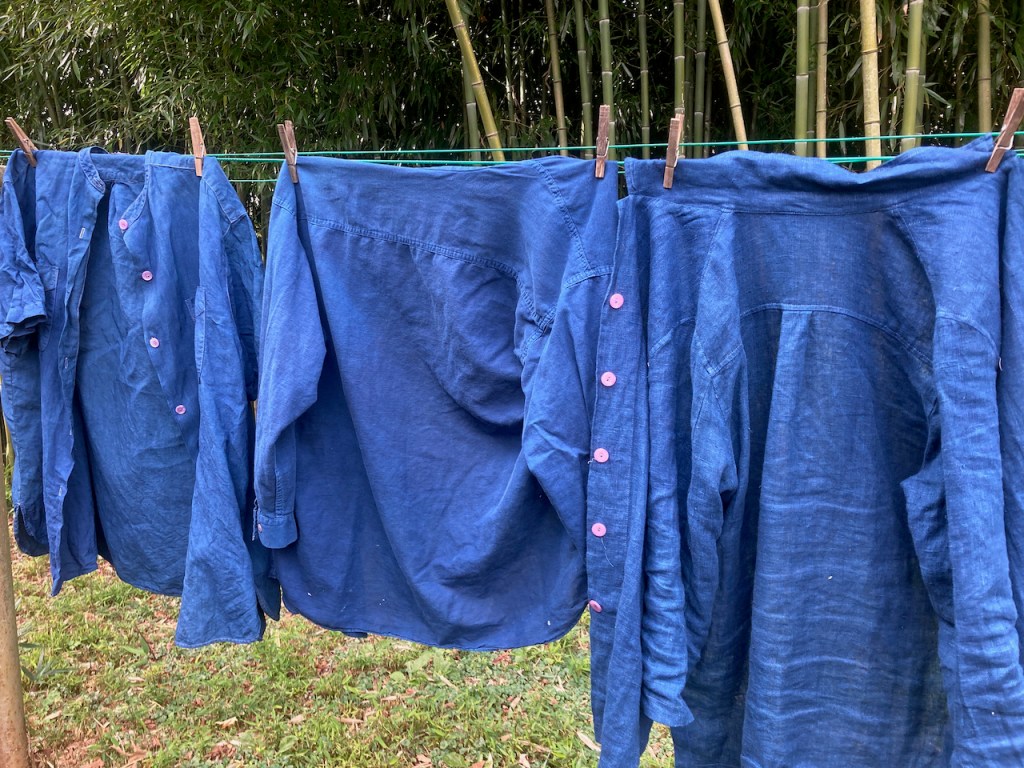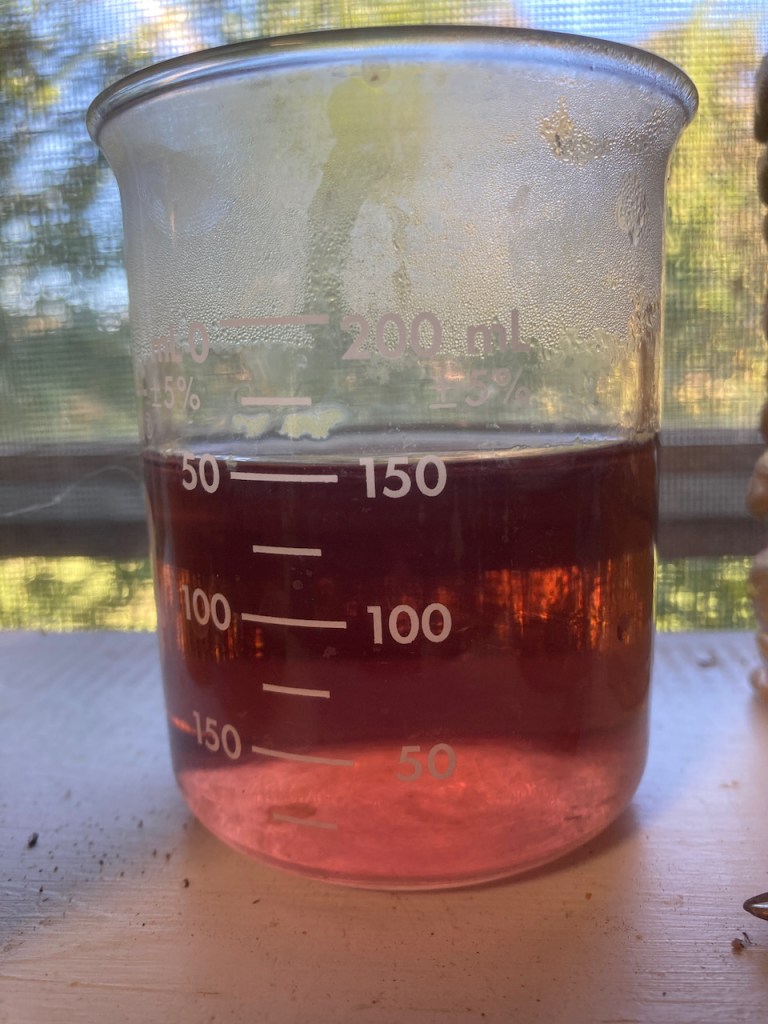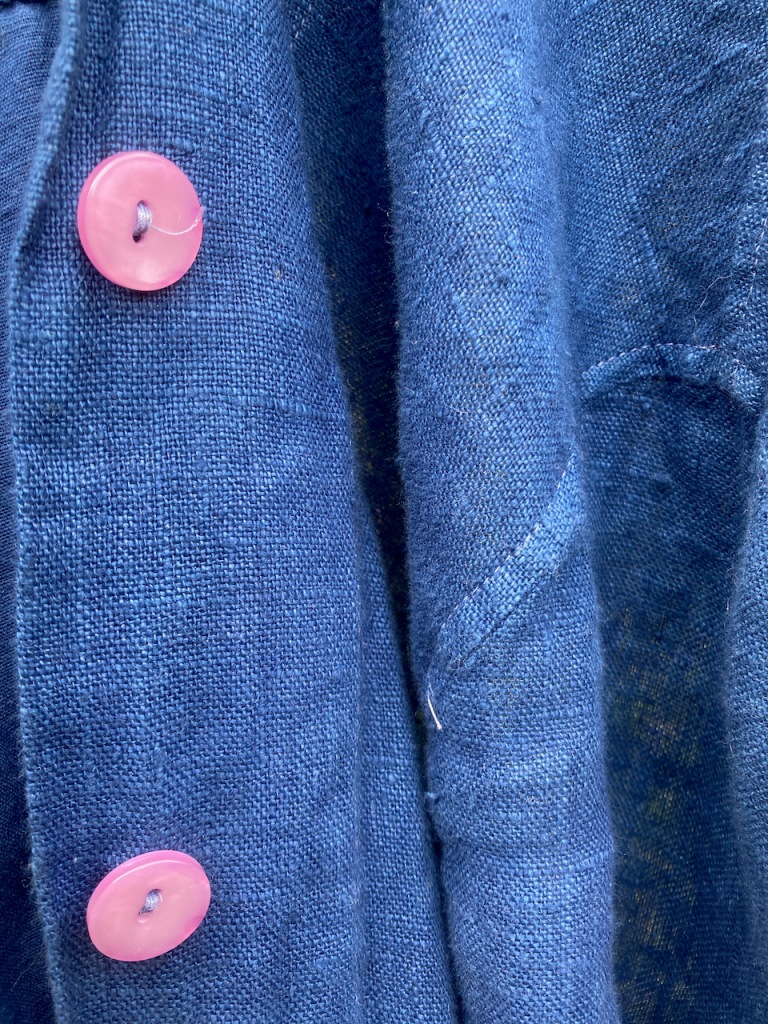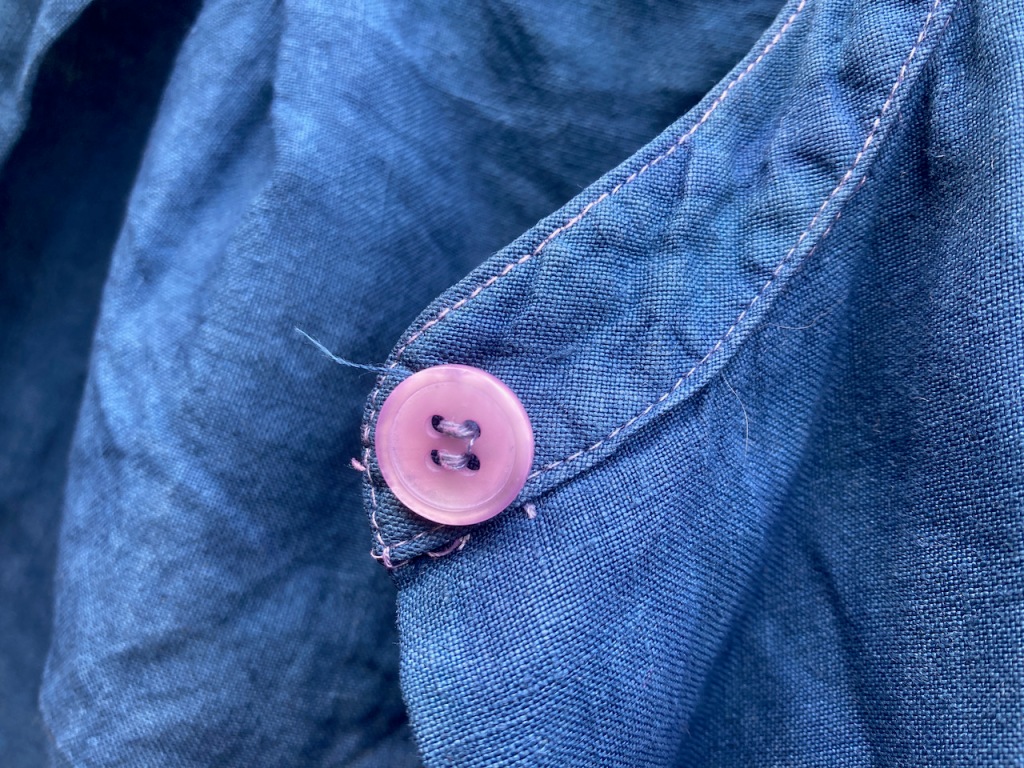Why would a white plastic button turn purple from an indigo dyebath?
Indirubin is one the most curious components of indigo. It is sometimes referred to as the “red” of indigo. Indirubin only occurs in natural indigo and you will not find it in a synthetically produced pigment. Indirubin is valued for its medicinal applications.
Some dyers have been successful at manipulating the extraction and pH of indigo in order to reveal the mysterious purple/red color of indirubin on a textile. I have no real experience with this process.
At one point I did learn how to analyze an indigo pigment in order to determine the presence of indirubin. If indirubin is present, it is an indicator that the pigment is made from plants and not synthetically produced. Natural indigo has varying amounts of indirubin. The process of analyzing uses solvents and chemicals so it is not something that I want to do on a regular basis.
I purchase all of my indigo pigment from Stony Creek Colors, as I know that their indigo comes from plants (and, consequently, contains plenty of indirubin).
Now that I maintain several large “active” indigo vats, I will occasionally dye a ready made garment. A white linen blouse is not a good choice for wearing apparel in the dye studio, but one that has been dyed a rich indigo blue is perfect.

After dyeing, just before the final rinse, I always boil an indigo dyed textile in order to remove any unattached dye. Cellulose is boiled vigorously with a small amount of neutral detergent for about 10 minutes. Wool and silk are brought to a near simmer and held at that temperature for the same amount of time.
Once I started using indigo from Stony Creek I noticed that the water from the final boil was always tinted a purple hue. I assumed this was the indirubin that was being rinsed from the textile. Interestingly, I observed that the purple color in the boil water is temporary, and will disappear as the bath cools.
Recently, I dyed some linen shirts that had plastic buttons. The buttons stayed white until the final boil. When the garment was removed from the boil bath, they had become purple. I have now learned that indirubin is less easily reduced and the undissolved indirubin will stain plastics and other petroleum derived materials. Some of the polyester threads used to sew the shirts are also tinted purple.
Summer Arrowood, the chemist at Stony Creek Colors, tells me that all the plastic vessels in her lab are dyed purple from the indirubin!
Will these buttons remain purple after multiple washings? I don’t know. There is always more to observe and learn from the natural dye process.





Oh how I wish I were a chemist.
Thank you for your interesting post about indirubin, I will check my final rinse carefully from now on to see if I get the same result from my homegrown persicaria tinctoria…
So fascinating. It has an affinity for plastic… Sounds like you could dye a polyester fabric purple.
I am a beginner and just did my first woad vat using fresh leaves and a honey/lime/yeast quick fermentation, from the recipe in Abigail Booth’s book. I got a nice blue and left the vat to sit for a week, during which time it got funky. I went ahead and dipped another piece of fabric and got pink, but when I neutralized with the vinegar/water, per your book, the pink was discharged from the fabric.
Another observation: about finishing the fabric. I dyed kona cotton with yellow cosmos this summer, and when I washed and rinsed the fabric, I watched all the gorgeous saturated rusty brickred-orange color drain out and was left with a disappointing pale orangey-beige. However, I saved one piece of the saturated fabric and let it sit, unrinsed for 3 months. When I recently finally washed and rinsed it, and rinsed and rinsed it, the color stayed!! So maybe a curing period is in order for some dyes…
A “curing” should not be necessary for a mordant dye. How did you mordant the cotton before dyeing with the cosmos?
I used fresh sumac leaves, gathered by the roadside, for the tannin–enough that they actually dyed the fabric a pale yellow. Then I used 4 t. McCormick pickling alum. I only do a yard at a time, divided into 4 pieces, using the method in your book, in a 3 gallon bucket. I don’t recall if I added soda ash in with the alum at that time. Probably. The pieces that were washed right away are a pale peachy color–not a bad color, really, but pale. The piece I let sit is a spectacular pumpkin pie color.
It does seem that I rinse and rinse and the water never goes clear. It always has a slight tinge of the dye color. Is that normal? This is true of everything I’ve dyed with, so maybe I really need to use alum acetate…? I am not a professional, so a little leeway is acceptable with the colorfastness, but after doing all that work I want colors that stick. Also, I do use a LOT of dye stuff, much more than I probably need for one yard.
Hi Catherine,
Could you speak of your method if boiling the finished indigo ? I have always just soaked in a 15% vinegar and water solution. Does the boiling take out alot of color ? Does it prevent crocking ? thanks,
Sara Burnett
I’m also curious about whether boiling as part of finishing the indigo dyed fibers reduces crocking. Knitting with indigo yarn can result in dye rubbing off…
I think that it does help some, although it is not the only factor. I began making fermentation vats partially to deal with this issue. The limited use of lye (calcium hydroxide) seems to have a positive effect on the crocking issue.
So interesting! Your posts are great, and I always learn something more! Thank you!!
This year’s indigo dyeing was with Stony Creek Indigo and I did observe as the yarn came out of the vat it had a reddish tone at first before turning blue. Iron vat.
Chemistry of naturevis so interesting.
Me too!
i like your ‘dyed’ buttons!
Catharine l love all your posts. This one os so interesting. I no longer dye or weave but lm still around and doing well for 89. Think you often and am so grateful you have been apart of my life.
Always nice to hear from you, dear Sally!
Hi Catherine, Are you sure those buttons are plastic? From the photos, they look like they could be vegetable ivory or tauga nut. Tauga nut takes up dye nicely.
It’s definitely plastic!
Really fascinating debate on Indigo and Indirubin.This might explain what appened a few years ago when I was washing a long evening wrap in pure wensleydale which I had handdyed with my own homegrown indigo in Sussex. Hot summer, japanese indigo but which one I dont iknow, Probably the small flowered variety as that is apparently the most known in UK. I think it was fresh, but might have been picked and dried and then used later. The yarn would have been washed and vinegar rinsed after dyeing. I have done this over many years. Imagine my shock when the whole garment turned purple. Bearing in mind it had bands of paler and darker indigo this was anything but desirable. After much cogitation I reckoned that it could have been different handsoap. (I now only use one handsoap for fewer shock horrors). I then used the. opposite rinsing addition i.e. assumption that the handsoap was more acidic, I added a tiny amount of vinegar and left it for 20 minutes. When I returned to the sink the whole garment had returned to its original indigo shades. Never happened again!!.
I must have another attempt to see whether I can repeat this. But I suspect that the purple is not fixed.
I also wonder whether it would be equally fugitive if washed in an acidic handsoap again.
Hi Julia, I am no expert in my indigo adventures, but I do have a soap making company for 22 years. Are you using a natural soap? Good natural soap is alkaline, not acidic. Maybe it’s the soap’s higher ph that temporarily gave your wrap its color variations, which is how I wash all of my hand made clothes. Then the vinegar rinse, which can have a ph of somewhere between 3-4, brought it back to it’s original indigo.
Yes, Wendy absolutely, this was a natural handsoap but it had citrus in it! so worth being extra careful if you are even washing indigo from another source. Your soap making company sounds lovely – tell us more, please.
blog is amazing, keep writing this type of blogs